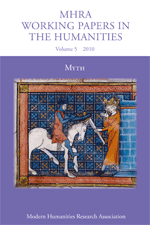MHRA Style Citation Demonstration
Click cover to enlarge | According to the MHRA Style Guide, this item should be cited in a bibliography as follows: McKeane, John, and Neilly, Joanna. 2011. ‘Myth’, in Myth, ed. by John McKeane and Joanna Neilly (= MHRA Working Papers in the Humanities, 5), pp. 1–77, doi:10.59860/wph.i6998a6 This is in the author-date variant of MHRA style. MHRA's journals don't allow author-date citation, but some of its book series (notably Legenda) do: please talk to your editor before using this. (To see the demonstration for regular style instead, follow this link.) Let's take this bibliography entry one step at a time: Step 1. We start with the name(s) of the author(s) of the article, inverting the first name into the form 'Forename, Surname'. McKeane, John, and Neilly, Joanna Step 2. In author-date style, we have a full stop, then the year, then another full stop. If there are multiple entries with the same author and year, letters would be used to distinguish them: e.g., Bloggs 1994a, Bloggs 1994b. McKeane, John, and Neilly, Joanna. 2011. Step 3. Now we add the title, in single inverted commas. Any single quotation marks already in the title must be converted to doubles. McKeane, John, and Neilly, Joanna. 2011. ‘Myth’ Step 4. We have to say where this comes from, so: McKeane, John, and Neilly, Joanna. 2011. ‘Myth’, in Step 5. Next we identify where the article is to be found, using italics, not quotation marks, for the volume title. This is actually a journal issue, but it's a themed number with a title, so we give that title here just as if it were a book. McKeane, John, and Neilly, Joanna. 2011. ‘Myth’, in Myth Step 6. After the title come any editors or translators. It's 'ed. by', not 'ed by', because although 'ed.' abbreviates 'edited', we regard the 'd' as the second letter of 'edited', not the last: so the abbreviation doesn't contain the last letter, and thus must have a full stop '.' McKeane, John, and Neilly, Joanna. 2011. ‘Myth’, in Myth, ed. by John McKeane and Joanna Neilly Step 7. We gave this a title as if it were a book, but we need to give the equivalent journal citation as well: note the '=' sign. McKeane, John, and Neilly, Joanna. 2011. ‘Myth’, in Myth, ed. by John McKeane and Joanna Neilly (= MHRA Working Papers in the Humanities, 5) Step 8. Now the pagination. And we use 'p.' or 'pp.' as appropriate. Journal articles used to omit 'pp.' in MHRA Style, but the Fourth Edition Guide (2024) removes this exception, so now page ranges in journals are treated just the same as in books. Number ranges are elided in the last two digits: thus '2234-2265' should be '2234-65', and '102-109' should be '102-09'. McKeane, John, and Neilly, Joanna. 2011. ‘Myth’, in Myth, ed. by John McKeane and Joanna Neilly (= MHRA Working Papers in the Humanities, 5), pp. 1–77 Step 9. This contribution has a DOI, so the Fourth Edition Guide (2024) requires us to quote it, like so. McKeane, John, and Neilly, Joanna. 2011. ‘Myth’, in Myth, ed. by John McKeane and Joanna Neilly (= MHRA Working Papers in the Humanities, 5), pp. 1–77, doi:10.59860/wph.i6998a6 And that's the finished bibliography entry. Note that there's no final full stop. So how about citations in the main text, or in footnotes or endnotes? The advantage of the author-date system is that these are very concise. In fact, you don't need a note at all. Suppose we quote from page 21: The author reminds us of Shakespeare’s view: ‘Better a foolish wit than a witty fool’ (McKeane and Neilly 2011: 21). And notes are concise too. There's no difference in how to treat the first and subsequent notes. 34 McKeane and Neilly 2011. So is author-date easier than regular MHRA style? Not always. Firstly, it may not be allowed by your editor, so check before using. But secondly, it makes books easier to write, but only at the cost of making them harder to proof-read. If you discover at the last moment that Blenkinsop 1996 was actually published in 1995, that can mean hundreds of corrections to make, and it gets worse if an author has many publications in the same year, because Blenkinsop 1996e and Blenkinsop 1996d are easy to confuse. |
